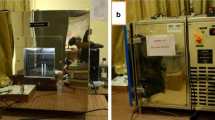Summary
The results of a wind tunnel and could chamber investigation on the effect of intense electric fields on ice-nucleation in supercooled water are presented. It is found that electrostatically charged surfaces and externally applied electric fields significantly enhance ice-nucleation. This finding is supported by a review of recent work reported in literature. Several mechanisms are considered which can be made responsible for electrofreezing. A discussion of the electrofreezing effect suggests that it is the electrical relief of the surface of a solid substrate rather than the crystallochemical relief which is the determining factor in heterogeneous ice nucleus formation.
Similar content being viewed by others
References
B. J. Mason,The physics of Cloud (Oxford University Press, London, 1972).
H. R. Pruppacher andM. Neiburger,Design and performance of the UCLA cloud tunnel, Proc. Int. Conf. Cloud Physics, Toronto (1968), 389–392.
K. V. Beard andH. R. Pruppacher,A determination of the terminal velocity and drag of small water drops by means of a wind tunnel, J. Atmos. Sci.26 (1969), 1066–1072.
K. V. Beard andH. R. Pruppacher,A wind tunnel investigation of the rate of evaporation of small water drops falling at terminal velocity in air, J. Atmos. Sci.28 (1971), 1455–1464.
L. Dufour,Über das Gefrieren des Wassers und über die Bildung des Hagels, Poggendorfs Ann. Physik114 (1861), 530–554.
W. Rau,Eiskeimbildung durch dielektrische Polarisation, Z.f. Naturforsch.6a (1951), 649–457.
V. J. Schaefer,Project Cirrus, Gen. Electric Res. Lab. Final Rept. (1953), 52.
R. W. Salt,Effect of electrostatic field on freezing of supercooled water and insects, Science133 (1961), 458.
H. R. Pruppacher,The effect of an external electric field on the supercooling of water drops, J. Geophys. Res.68 (1963), 4463–4474.
H. R. Pruppacher,The effects of electric fields on cloud physical processes, J. Appl. Math. and Phys. (ZAMP)14 (1963), 590–599.
M. Roulleau,Influence of an electric field on the freezing of water, Ann. Geophys.20 (1964), 319–324.
M. Roulleau andM. Poc,Électrocongélation des brouillards surfondus, Compte. Rend.264 (1967), 1480–1483.
M. Poc,Électrocongélation des brouillards surfondus, J. de Rech. Atmos.3 (1967), 127–137.
C. Garraud,Rôle du givrage des électrodes dan l'électrocongélation des brouillards surfondus, Compte Rend.268 (1969), 1042–1044.
V. J. Schaefer,The generation of large numbers of ice crystals in an electric field, J. Appl. Meteorol.7 (1968), 452–455.
M. Roulleau, L. F. Evans andN. Fukuta,The electrical nucleation of ice in supercooled clouds, J. Atmos. Sci.28 (1971), 737–740.
M. A. Abbas andJ. Latham,The electrofreezing of supercooled water drops, J. Meteorol. Soc. Japan47 (1969), 65–74.
M. H. Smith, R. F. Griffiths andJ. Latham,The freezing of raindrops falling through strong electric fields, Quart. J. Roy. Meteorol. Soc.97 (1971), 495–505.
L. R. Koenig,Drop freezing through drop breakup, J. Atmos. Sci.22 (1965), 448–451.
T. G. Gabarashvili andN. V. Gliki,Origination of the ice phase in supercooled water under the influence of electrically charged crystals, Izvestiya Acad. Sci. USSR Atmospheric and Oceanic Physics3 (1967), 570–574.
F. Albani,Sur l'action glacogène de l'étincelle électrique sur les images surfondus, Bull. Obs. Puy de Dôme No. 1 (1965), 7–10.
D. C. Blanchard,Electrostatic field and freezing, Science133 (1961), 1678.
L. B. Loeb,A tentative explanation of the electric field effect on the freezing of supercooled water drops, J. Geophys. Res.68 (1963), 4475.
L. B. Loeb, A. F. Kip andA. W. Einarsson,On the nature of ionic sign preference in Wilson Cloud Chamber condensation experiments, J. Chem. Phys.6 (1938), 264–273.
A. Rahman andF. H. Stillinger,Molecular dynamics study of liquid water, J. Chem. Phys.55 (1971), 3336–3359.
L. Dufour andR. Defay,Thermodynamics of Clouds (Akademic Press, New York, 1963).
L. F. Evans,The role of the adsorbed layer in ice nucleation, Proc. Conf. Cloud Physics, Fort Collins (1970), 14.
G. Nemethy andH. A. Scheraga,Structure of water and hydrophobic bonding in proteins, J. Chem. Phys.36 (1962), 3401–3417.
H. H. Jellinek, M. D. Luh, andV. Nagarajan,Sorbed water on polymers near 0°C, Koll. Z. und Z. f. Polymere232 (1969), 758–763.
N. R. Gokhale,Dependence of ice nucleating efficiencies of chemical aerosols in a supercooled cloud and bulk water, Proc. Int. Conf. on Cloud Physics, Tokyo (1965), 176–180.
T. E. Hoffer,A laboratory investigation of droplet freezing, J. of Meteorol.18 (1961), 766–778.
N. R. Gokhale andJ. D. Spengler,Freezing of freely suspended, supercooled water drops by contact nucleation, J. Appl. Meteorol.11 (1972), 157–160.
N. Gokhale andJ. Goold,Droplet freezing by surface nucleation, J. Appl. Meteorol.7 (1968), 870–874.
J. Latham,The electrification of snowstorms and sandstorms, Quart. J. Roy. Meteorol. Soc.90 (1964), 91–95.
K. L. Chopra,Growth of thin metal films under applied electric field, Appl. Phys. Letters7 (1965), 140–142.
K. L. Chopra,Influence of electric field on the growth of thin metal films, J. Appl. Phys.37 (1966), 2249–2254.
K. Mihana andM. Tanaka,An electrostatic field effect in the epitaxial growth of gold particles evaporated onto sodium chloride, J. Crystal Growth2 (1968), 51–53.
V. P. Vlasov, Y. M. Gerasimov andG. I. Distler,Electrical relief of the surface of a crystal substrate as the determining factor in nucleus formation and growth, Soviet Physics, Crystallography15 (1970), 289–293.
Author information
Authors and Affiliations
Additional information
This work was supported by the National Science Foundation under grant No. GA-32814
Rights and permissions
About this article
Cite this article
Pruppacher, H.R. Electrofreezing of supercooled water. PAGEOPH 104, 623–634 (1973). https://doi.org/10.1007/BF00875907
Received:
Issue Date:
DOI: https://doi.org/10.1007/BF00875907




